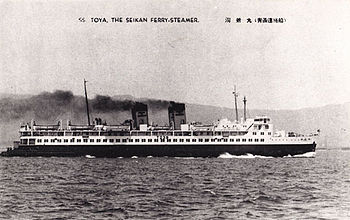Tōya Maru

Toya Maru at an unknown date
|
|
| History | |
|---|---|
| Name: | Tōya Maru |
| Owner: | Japanese National Railways |
| Port of registry: |
|
| Builder: | Mitsubishi Heavy Industries, Kobe, Japan |
| Yard number: | 816 |
| Launched: | 21 November 1947 |
| In service: | 1948 |
| Out of service: | 26. September 1954. |
| Fate: | Sank during a typhoon in the Tsugaru Strait between the Japanese islands of Hokkaidō and Honshū on 26 September 1954 |
| General characteristics | |
| Class and type: | RO/RO ferry |
| Tonnage: | 3,898 t (3,836 long tons) |
| Length: | 118.7 m (389 ft) |
| Beam: | 15.85 m (52.0 ft) |
| Speed: | 20 knots |
| Capacity: | 1,128 passengers |
| Crew: | 120 crew |
The Tōya Maru (洞爺丸?) was a Japanese train ferry constructed by the Japanese National Railways which sank during a typhoon in the Tsugaru Strait between the Japanese islands of Hokkaidō and Honshū on September 26, 1954. The Japanese National Railways announced in September 1955 that 1,153 people aboard were killed in the accident. However, the exact number of fatalities remains unknown because there were victims who managed to obtain passage on the ship at the last minute, and others who cancelled their tickets just before the incident occurred.
The Tōya Maru was launched on November 21, 1947. It was 118.7 m (389 ft) long and 15.85 m (52.0 ft) at its beam and it had a gross register tonnage of 3,898 t (3,836 long tons). It could accommodate 1,128 passengers and was operated by a crew of 120. It covered the distance from Aomori to Hakodate in 4 hours and 30 minutes.
As early as 1950, it was fitted with radar equipment, becoming one of the first Japanese sea liners to be so equipped. It was used by the Emperor the month before it sank. It was also famous as the flagship of the Tsugaru Strait.
Typhoon No. 15, Marie, which had blown through Honshū, was in the Sea of Japan at 12:00 on September 26, 1954, heading northeast and had wind speeds of more than 100 kilometers an hour. It was predicted to reach the Tsugaru Strait at around 17:00.
At 11:00, the Tōya Maru arrived at Hakodate after its first journey that day from Aomori. It was originally scheduled to return at 14:40, to arrive at Aomori just before Typhoon Marie. However, due to the expected storm, another ferry—the Dai 11 Seikan Maru, a somewhat poorer quality vessel—could not depart on its scheduled journey to Hakodate. Therefore, passengers and vehicles were transferred to the Tōya Maru, delaying its departure.
...
Wikipedia
